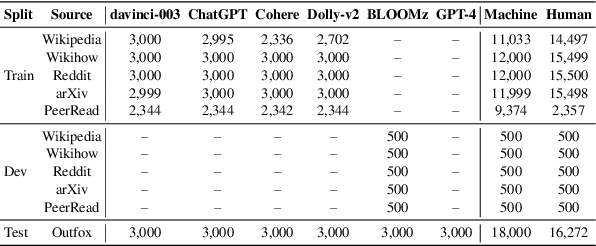Petar Ivanov
SemEval-2024 Task 8: Multidomain, Multimodel and Multilingual Machine-Generated Text Detection
Apr 22, 2024



Abstract:We present the results and the main findings of SemEval-2024 Task 8: Multigenerator, Multidomain, and Multilingual Machine-Generated Text Detection. The task featured three subtasks. Subtask A is a binary classification task determining whether a text is written by a human or generated by a machine. This subtask has two tracks: a monolingual track focused solely on English texts and a multilingual track. Subtask B is to detect the exact source of a text, discerning whether it is written by a human or generated by a specific LLM. Subtask C aims to identify the changing point within a text, at which the authorship transitions from human to machine. The task attracted a large number of participants: subtask A monolingual (126), subtask A multilingual (59), subtask B (70), and subtask C (30). In this paper, we present the task, analyze the results, and discuss the system submissions and the methods they used. For all subtasks, the best systems used LLMs.
* 23 pages, 12 tables
M4GT-Bench: Evaluation Benchmark for Black-Box Machine-Generated Text Detection
Feb 17, 2024



Abstract:The advent of Large Language Models (LLMs) has brought an unprecedented surge in machine-generated text (MGT) across diverse channels. This raises legitimate concerns about its potential misuse and societal implications. The need to identify and differentiate such content from genuine human-generated text is critical in combating disinformation, preserving the integrity of education and scientific fields, and maintaining trust in communication. In this work, we address this problem by introducing a new benchmark involving multilingual, multi-domain and multi-generator for MGT detection -- M4GT-Bench. It is collected for three task formulations: (1) mono-lingual and multi-lingual binary MGT detection; (2) multi-way detection identifies which particular model generates the text; and (3) human-machine mixed text detection, where a word boundary delimiting MGT from human-written content should be determined. Human evaluation for Task 2 shows less than random guess performance, demonstrating the challenges to distinguish unique LLMs. Promising results always occur when training and test data distribute within the same domain or generators.
M4: Multi-generator, Multi-domain, and Multi-lingual Black-Box Machine-Generated Text Detection
May 24, 2023



Abstract:Large language models (LLMs) have demonstrated remarkable capability to generate fluent responses to a wide variety of user queries, but this has also resulted in concerns regarding the potential misuse of such texts in journalism, educational, and academic context. In this work, we aim to develop automatic systems to identify machine-generated text and to detect potential misuse. We first introduce a large-scale benchmark M4, which is multi-generator, multi-domain, and multi-lingual corpus for machine-generated text detection. Using the dataset, we experiment with a number of methods and we show that it is challenging for detectors to generalize well on unseen examples if they are either from different domains or are generated by different large language models. In such cases, detectors tend to misclassify machine-generated text as human-written. These results show that the problem is far from solved and there is a lot of room for improvement. We believe that our dataset M4, which covers different generators, domains and languages, will enable future research towards more robust approaches for this pressing societal problem. The M4 dataset is available at https://github.com/mbzuai-nlp/M4.
 Add to Chrome
Add to Chrome Add to Firefox
Add to Firefox Add to Edge
Add to Edge